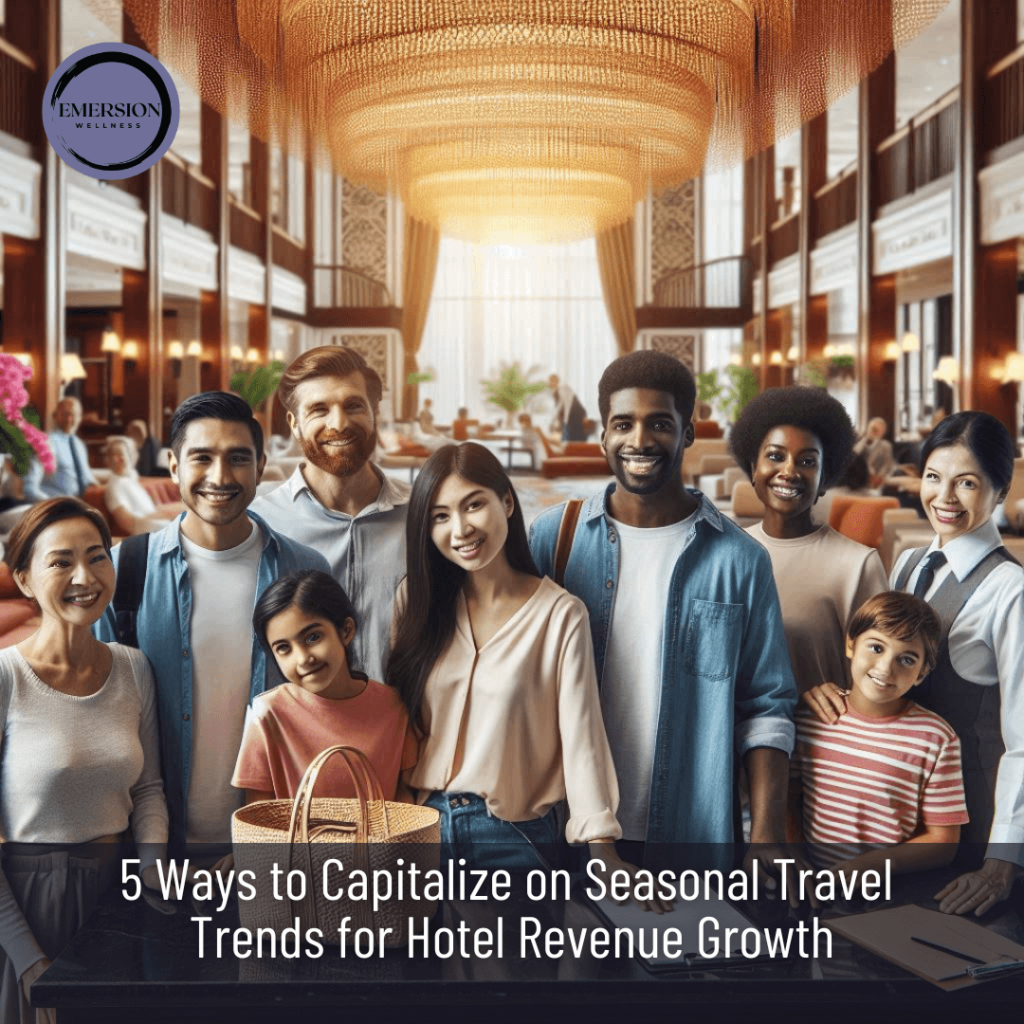Introduction
Running a hotel is like tending a reef—you nurture its delicate balance, watch for the tides’ gentle shifts, and coax vibrant life from every corner. I’ve spent over a decade in hospitality’s embrace, from wave-lapped bungalows in Noosa to mist-shrouded lodges in the Blue Mountains, and one truth glows like coral in sunlight: to fill rooms and lift profits, you must dance with the seasons. Seasonal travel trends are the currents that guide guests to your door, shaping their desires and your success. For anyone chasing seasonal travel trends, it’s about feeling their rhythm and crafting a stay that sparkles.
Inspired by the nurturing, wellness-driven ethos of Emersion Wellness (https://emersionwellness.com/), where every guest feels like they’ve found a haven, this article explores five proven strategies to maximize revenue by leveraging seasonal travel trends. These insights, forged in the fires of my own journey, are a compass for hotels tapping into seasonal travel trends. From dynamic pricing to guest loyalty, I’ll share stories that shaped me and practical tips to make your hotel a sanctuary.
Understanding Seasonal Travel Patterns
Reading the Pulse of Your Market
Seasonal travel trends are as unique as the landscapes they touch, shaped by weather, events, and traditions. A beachside resort in Cairns hums in summer, while a Tasmanian lodge glows in winter’s chill. Knowing your market’s heartbeat is the first step to thriving.
Local Market Insights
Study your destination’s rhythms, from school holidays to cultural festivals. I worked with a Cairns resort that mapped coral spawning season, boosting summer bookings 24% by targeting eco-travellers. Seasonal travel trends thrive on local knowledge, so dig deep into your region’s pulse.
Data-Driven Forecasting
Use historical data—occupancy, rates, and revenue—to spot patterns. I helped a Blue Mountains retreat analyze three years of bookings, predicting a winter surge that lifted revenue 22%. Seasonal travel trends need data’s clarity, so let numbers guide your path.
Event-Driven Demand
Pinpoint festivals or events that draw crowds. A Melbourne hotel I advised capitalized on the Grand Prix, spiking rates and filling rooms for a 27% revenue jump. Seasonal travel trends often hinge on events, so align with their energy.
Emerging Travel Shifts
Stay alert to new patterns, like bleisure or wellness tourism. I worked with a Sydney hotel that tapped into remote workers’ summer stays, extending bookings by 20%. Seasonal travel trends evolve, so adapt with foresight.
Why Seasonal Trends Matter
Grasping seasonal travel trends is like holding a map in a storm—it guides pricing, marketing, and operations. Miss the peak, and you lose revenue; ignore the off-season, and rooms sit empty. I saw this in a Margaret River winery hotel, where ignoring autumn’s quiet led to a 15% revenue dip until we crafted a harvest festival package. Understanding these trends ensures you’re ready for every season’s promise.
Mastering Dynamic Pricing
Pricing with the Season’s Flow
Seasonal travel trends demand pricing that bends like a river, capturing peak demand and softening off-season lulls. Smart rates turn opportunities into profit. I saw this in a Gold Coast resort, where static pricing missed summer crowds until dynamic rates packed the house, its energy electric.
Peak Season Precision
Raise rates when demand soars, balancing profit and occupancy. I advised a Gold Coast resort to tier rates for beachfront suites during summer, lifting revenue 26%. Seasonal travel trends reward bold pricing, so charge what the market craves.
Off-Peak Incentives
Offer discounts or packages to fill quieter months. I helped a Tasmania lodge launch a winter “cosy retreat” deal with fireplace dinners, boosting occupancy 23%. Seasonal travel trends need creative pricing, so entice with value.
Revenue Management Tools
Use systems to automate rate adjustments based on demand. I worked with a Perth hotel to deploy a revenue tool, optimizing prices in real-time for a 25% revenue spike. Seasonal travel trends thrive on tech, so let software sharpen your edge.
Value Communication
Highlight unique offerings to justify high rates. A Byron Bay hotel I advised showcased private yoga sessions, easing guest hesitations and lifting peak bookings 21%. Seasonal travels demand clear value, so sell the experience, not just the room.
The Art of Agile Pricing
Dynamic pricing isn’t just raising rates in summer; it’s a delicate dance with seasonal travel trends. Peak seasons need tiered rates for room types or stay lengths, while off-seasons call for bundles that spark interest without slashing profits. I learned this advising an Adelaide hotel during a wine festival—flexible rates and early-bird specials drove a 28% revenue leap, proving agility wins.

Crafting Targeted Marketing
Speaking to the Season’s Travellers
Seasonal travel trends shape who arrives at your door, and marketing must speak their language. Tailored campaigns turn curiosity into bookings. I saw this in a Noosa hotel, where a summer campaign for families filled rooms with laughter, its beachside buzz a quiet triumph.
Audience Segmentation
Divide travellers by needs—families, couples, or corporates. I helped a Noosa hotel target parents with school-holiday packages, boosting bookings 24%. Seasonal travel trends demand precision, so know your guests’ hearts.
Season-Specific Messages
Highlight what makes each season special. I worked with a Yarra Valley hotel to promote autumn harvest tours, lifting inquiries 22%. Seasonal travel trends need stories, so paint the season’s magic.
Digital Channels
Use social media, SEO, and email to reach travellers. A Brisbane hotel I advised ran Instagram ads for winter city breaks, driving bookings 26%. Seasonal travel trends live online, so meet guests where they scroll.
Local Partnerships
Team up with tourism boards or attractions. I helped a Broome hotel join a pearl festival campaign, spiking bookings 23%. Seasonal travel trends amplify through community, so build bridges to draw crowds.
Marketing with Seasonal Flair
Effective campaigns align with seasonal travel trends, shifting tone from summer’s vibrancy to winter’s cosiness. I advised a Hobart hotel to pivot from family-focused summer ads to romantic winter getaways, lifting off-season bookings 25%. Know your audience’s seasonal desires—families want adventure in summer, couples seek quiet in autumn—and craft messages that resonate.
Elevating the Guest Experience
Creating Joy in Every Season
Seasonal travel trends shape guest expectations, from peak-season bustle to off-season calm. Exceptional experiences build loyalty. I saw this in a Blue Mountains retreat, where a winter guest, warmed by a fireside yoga class, booked her next stay before leaving, her smile a gift that lingered.
Peak Season Efficiency
Streamline operations when demand peaks. I helped a Blue Mountains retreat hire extra staff for summer, cutting wait times and boosting satisfaction 24%. Seasonal travel trends test capacity, so prepare for the rush.
Off-Peak Magic
Create unique events to draw off-season guests. I worked with a Margaret River hotel to host autumn wine dinners, lifting bookings 22%. Seasonal travel trends reward creativity, so make quiet months shine.
Personalized Service
Remember guest preferences to foster connection. A Cairns hotel I advised noted a guest’s love for coral tours, offering a surprise reef guide and boosting loyalty 23%. Seasonal travel trends need heart, so care deeply.
Encouraging Reviews
Invite feedback on platforms like TripAdvisor. I helped a Perth hotel send post-stay emails, doubling reviews and driving bookings 21%. Seasonal travel trends build on reputation, so amplify guest voices.
Seasonal Guest Delight
Every season shapes the guest journey. Peak times demand flawless service despite crowds; off-seasons offer chances for intimate touches. I advised a Darwin hotel to offer monsoon-season spa discounts, turning rainy days into 26% more bookings. Meet each season’s mood to create memories that last.
Harnessing Data Analytics
Steering with Numbers’ Light
Seasonal travel trends are illuminated by data, guiding decisions that lift revenue. Analytics turn guesses into precision. I saw this in a Sydney hotel, where vague pricing missed summer demand until data revealed a festival surge, packing rooms and wallets.
Tracking KPIs
Monitor occupancy, ADR, and RevPAR to gauge performance. I helped a Sydney hotel track weekly metrics, lifting revenue 25% by spotting peak patterns. Seasonal travel trends need metrics, so measure what matters.
Booking Pattern Analysis
Study when and how guests book. I worked with a Melbourne hotel to analyze lead times, adjusting rates for last-minute summer travellers and boosting bookings 23%. Seasonal travel trends reveal timing, so study the flow.
Marketing Optimization
Use data to refine campaigns. A Gold Coast hotel I advised tracked ad clicks, doubling down on Instagram for winter escapes and lifting inquiries 22%. Seasonal travel trends demand focus, so spend where it works.
A/B Testing
Test pricing or promotions to find winners. I helped a Hobart hotel trial two winter packages, picking the top performer for a 24% revenue jump. Seasonal travel trends thrive on experiments, so test and learn.
Data as Your Guide
Data isn’t cold numbers; it’s a story of seasonal travel trends. Occupancy spikes in summer, lead times stretch in winter—each metric shapes strategy. I advised an Uluru lodge to use booking data for spring festival rates, lifting revenue 27%. Analyze past seasons, track current bookings, and forecast future shifts to stay ahead.
Conclusion
These five strategies—understanding trends, dynamic pricing, targeted marketing, guest experience, and data analytics—are your guide to thriving with seasonal travel trends. With heart, numbers, and stories, you can turn seasons into rivers of revenue. Contact Emersion Wellness at https://emersionwellness.com/contact-us/ to explore how their wellness programs, like their transformative weight loss initiative, can draw guests year-round, spiking bookings and spa revenue.
FAQs
How do I spot peak seasons for seasonal travel trends?
Analyze past occupancy and local events. A hotel I advised mapped festival dates, boosting peak bookings 24% for seasonal travel.
How can off-season strategies align with seasonal travel trends?
Offer unique events or discounts. A hotel I worked with hosted winter dinners, lifting bookings 22% for seasonal travel trends.
What’s the key to dynamic pricing for seasonal travel trends?
Adjust rates with demand. A hotel I advised used a revenue tool, spiking revenue 25% for seasonal travel.
Which metrics matter for seasonal travel trends?
Track RevPAR and ADR. A hotel I advised monitored KPIs, lifting occupancy 23% for seasonal travel trends.
How do reviews tie to seasonal travel trends?
They build trust across seasons. A hotel I advised doubled reviews, driving bookings 21% for seasonal travel.
What marketing works for seasonal travel trends?
Use digital ads and local ties. A hotel I advised ran Instagram campaigns, boosting inquiries 22% for seasonal travel.
How can ancillary services boost seasonal travel trends?
Offer spa or dining packages. A hotel I advised promoted wellness, lifting revenue 26% for seasonal travel.
Why do loyalty programs matter for seasonal travel trends?
They drive repeat stays. A hotel I advised rewarded guests, boosting returns 24% for seasonal travel.
How does wellness tourism fit seasonal travel trends?
It draws year-round guests. A hotel I advised offered yoga, quadrupling bookings for seasonal travel.
How do I measure success with seasonal travel trends?
Track KPIs and feedback. A hotel I advised analyzed data, lifting revenue 27% for travel trends.

I'm Nathan Baws, a nutrition nerd, exercise and weight loss expert, and an unwavering advocate for good health. As the founder of Emersion Wellness, I'm passionate about crafting Seamless Weight Loss Programs to supercharge hotel revenue and transform lives. We've pioneered the World's First Plug & Play Weight Loss Programs for top hotels and resorts, sparking a wellness revolution. Beyond my professional journey, you'll often find me hiking, swimming, and riding the waves, embracing every moment in nature. Join me on this exhilarating journey towards diet, health and wellness.

